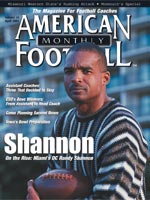Article CategoriesAFM Magazine
|
Rushing AheadMissouri Western State\'s passing attack alternative...the run gameOffensive Line Coach, Missouri Western State College © More from this issue Over the past five years we have had quarterbacks who have been 6-foot-1 or less. For this reason we have been in the shotgun a considerable amount of the time. We wanted to have threats with plays other than the passing game. We have been good throwing the ball but we needed more. We are always trying to gain yards but we also want to eliminate the negative yardage plays. We have added several plays over time. Most of them we have copied from someone
somewhere along the line. I am going to discuss three of them with you. These
three will all have the same backfield action and look the same initially. The
tailback will be offset at 45 degrees, and at an arms length from the quarterback.
|
|
|||||||
| HOME |
MAGAZINE |
SUBSCRIBE | ONLINE COLUMNISTS | COACHING VIDEOS |
Copyright 2025, AmericanFootballMonthly.com
All Rights Reserved





